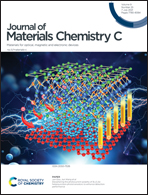A novel scintillation screen for achieving high-energy ray detection with fast and full-color emission†
Abstract
Traditional inorganic scintillation crystals have a high stopping power to high-energy particles or rays; however, their wide applications are limited due to the fixed emission band. CsPbX3 (X = Cl, Br, I) perovskite nanocrystals (CsPbX3 NCs) have been proved to achieve full-color emission and effective X-ray detection, but failed to detect γ-rays effectively due to their weak absorption ability. Therefore, based on the advantages of the tunable spectra for CsPbX3 NCs and the high stopping ability of a BaF2 single crystal, a novel CsPbX3 NCs@BaF2 scintillation screen is developed ingeniously for realizing fast and full-color emission under high-energy ray excitation. The CsPbX3 NCs@BaF2 scintillation screen exhibits a tunable emission ranging from 435 to 648 nm under hard X-ray excitation. It is of note that the light yield of the CsPbBr3 NCs@BaF2 scintillation screen can reach up to 6300 photons per MeV and it shows a fast decay time component (∼11 ns) under γ-ray excitation. The purpose of this contribution is to provide a new solution for guiding the perovskite materials as potential scintillators for fast and full-color emission expanding the application of high-energy radiation detection.



 Please wait while we load your content...
Please wait while we load your content...